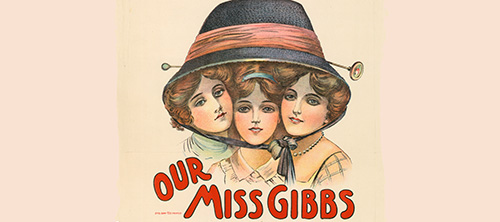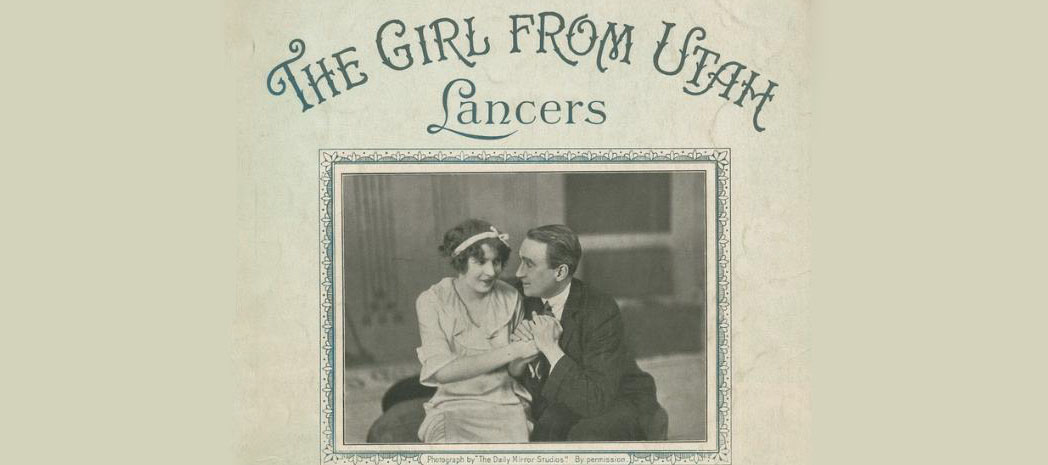Pas de biographie disponible.
Compositeur Musique additionelle Librettiste Parolier Metteur en scène Chorégraphe Producteur création Producteur version

Musical
Musique: F. Osmond Carr • Paroles: Adrian Ross • Livret: Adrian Ross • James T. Tanner • Production originale: 0 version mentionnée
Dispo: Résumé Synopsis Génèse
Genèse: In Town was first produced by George Edwardes at the Prince of Wales Theatre, opening on 15 October 1892, and transferred to the Gaiety Theatre on 26 December 1892, running for a successful 292 performances. It starred Arthur Roberts, together with Edmund Payne, Eric Lewis, and singing star Florence St John. Topsy Sinden danced in the piece.[4] The musical was produced on Broadway, for a run of 40 performances, opening on 6 September 1897 at the Knickerbocker Theatre, starring W. Louis Bradfield as Arthur Coddington and Marie Studholme as Kitty. In Town was one of the first Edwardian musical comedies on the London stage. It was lighter than a Gilbert and Sullivan style comic opera, but more coherent in construction than a burlesque. The piece initiated Tanner's and Edwardes's famous series of modern-dress musical shows and helped set the new fashion for the series of Gaiety Theatre musical hits that followed. Many of the best-known London couturiers began to design costumes for stage productions by the 1880s. The illustrated periodicals were eager to publish photographs of the actresses in the latest stage hits, and so the theatre became an excellent way for clothiers to publicise their latest fashions. After In Town, the Edwardian musical comedies would dominate the musical stage in Britain, and contribute to musical theatre throughout the English-speaking world and beyond, until the 1920s.[10]
Résumé: Captain Coddington, a penniless lad-about-town, gives a young aristocrat friend, Lord Clanside, a tour of the slightly naughty lifestyles both high and low, to be found in London. Coddington invites all the ladies of the Ambiguity Theatre to lunch; Clanside agrees to pay the bill if he is invited to the party. Afterwards, with several uninvited guests, they visit the theatre to see a rehearsal. Coddington romances the prima donna of the theatre and wins her.
Création: 15/10/1892 - Prince of Wales Theatre (Londres) - représ.

Musical
Musique: Ivan Caryll • Lionel Monckton • Paroles: Adrian Ross • Percy Greenbank • Livret: James T. Tanner • Production originale: 2 versions mentionnées
Dispo: Résumé Synopsis Commentaire Génèse Liste chansons
Genèse: Produced by George Edwardes, it opened at the Gaiety Theatre in London on 23 January 1909 and ran for an extremely successful 636 performances. It starred Gertie Millar, Edmund Payne and George Grossmith, Jr. The young Gladys Cooper played the small role of Lady Connie. The show also had a short Broadway run in 1910. It was revived at the Finborough Theatre, London, in May 2006. This was the first professional London production since 1910. The piece was regularly revived by amateur theatre groups, particularly in Britain, from the 1920s into the 1950s but it has been produced only rarely since then. Our Miss Gibbs was revived by Lyric Theatre in July and August 2011 at the Mountain View Center for the Performing Arts and the Lesher Center for the Arts in Walnut Creek, California. The revival featured a cast of 22 and a 9-piece orchestra.
Résumé: Mary Gibbs, a Yorkshire Lass, works in the flower department of Garrod’s Department Store. Her heart belongs to the bank clerk Harry Lancaster (who is really Lord Eynsford in disguise). Lord Eynsford is engaged to Lady Elizabeth Thanet, but she much prefers Hughie Pierrepoint, an amateur criminal. When Mary discovers Lord Eynsford’s deception, she leaves her job and goes off to the Franco-British Exhibition at White City. Lord Eynsford follows her, proves his honourable intentions, and all gets sorted out happily.
Création: 23/1/1909 - Gaiety Theatre (Londres) - 636 représ.

Musical
Musique: Lionel Monckton • Paroles: Livret: James T. Tanner • Production originale: 1 version mentionnée
Dispo: Résumé Synopsis Génèse Liste chansons
Genèse: Adelphi Theatre, London 5th November, 1910 - (536 perfs) Park Theatre, Broadway - 23 October, 1911 (240 perfs) The text was revised and the play revived at the London Coliseum on 25th May, 1944. This production closed owing to flying bombs, went on tour, and later opened again in London, this time at the Stoll Theatre in February, 1945 "THE QUAKER GIRL" then toured England and Scotland continuously from the Summer of 1945, until December, 1948, being received everywhere with great enthusiasm.
Résumé: Retaining the story structure and most of Lionel Monckton's music, this skilful adaptation with a new orchestration has pared down the Acts from three to two and added three entirely new songs, while still preserving the charm and entertainment of the popular original. Mathilde, an exiled French princess, secretly marries Captain Charteris in an English country village where she has befriended a young Quaker girl, Prudence, with whom American Tony Chute has fallen madly in love. Upbraided by the Quakers for attending the wedding festivities, Prudence accepts the wedding party's invitation to accompany them to Paris where she becomes an instant success. Mathilde is sought by the police who enlist the help of her ex-fiancd, Prince Carlo. To protect Mathilde, Prudence is blackmailed into accepting Prince Carlo's invitation to a ball he gives on the night of the Chantilly races. Unaware of her selfless motive, Tony is enraged with Prudence. However Prudence's innate goodness bears results and the senior French Minister allows Mathilde to remain in France, Tony and Prudence are reunited and the toast of the ball is The Quaker Girl!
Création: 5/11/1910 - Adelphi Theatre (Londres) - 536 représ.

Musical
Musique: Lionel Monckton • Paroles: Adrian Ross • Percy Greenbank • Livret: James T. Tanner • Production originale: 1 version mentionnée
Dispo: Synopsis Commentaire Génèse Liste chansons
Genèse: The Dancing Mistress was presented by the impresario George Edwardes at the Royal Adelphi Theatre, opening on 19 October 1912. The piece, which followed the same composer's and authors' immensely successful The Quaker Girl, featured many of the performers from the earlier show, including the romantic leads, Gertie Millar and Joseph Coyne. It ran at the Adelphi until 21 June 1913. A touring company presented the piece in the British provinces, with Adele Crispin, John T. MacCallum and Laura Wright in the leading roles of Nancy, Teddy and Virginie.
Résumé:
Création: 19/10/1912 - Adelphi Theatre (Londres) - 242 représ.

Musical
Musique: Paul Rubens • Sidney Jones • Paroles: Adrian Ross • Percy Greenbank • Livret: James T. Tanner • Production originale: 3 versions mentionnées
Dispo: Résumé Génèse Liste chansons
Genèse: La pièce fut créée à l'Adelphi Theatre de Londres le 18 octobre 1913 et connut une première série de 195 représentations. Une version américaine a été produite par Charles Frohman qui a eu connu un beau succès de 140 représentations au Knickerbocker Theatre (ouverture le 24 août 1914). Frohman a engagé le jeune Jerome Kern pour écrire cinq nouvelles chansons pour la partition avec le parolier Herbert Reynolds pour renforcer ce qu’il considérait comme un premier acte faible. Julia Sanderson et Donald Brian ont joué dans la production. Leur chanson "They Didn’t Believe Me" est devenue un succès. La comédie musicale a également tourné dans d’autres pays, dont l’Afrique du Sud, l’Australie et la Nouvelle-Zélande.
Résumé: Una Trance fuit sa maison et son mormonisme après la décision de son père de la "céder" à un habitant particulièrement horrible de Salt Lake City. Dans sa fuite, Una rencontre des bénévoles: Lord Amesham et sa fiancée, Dora; l’acteur Sandy Blair; un petit vendeur de jambon et de bœuf plutôt étrange, Trimmit et sa fiancée, Clancy, qui est aussi la bonne de Dora. Les choses deviennent plus mélodramatiques quand le redouté polygame attire Una et la moitié du chœur du Théâtre de la Folie dans sa demeure de Brixton, tandis que la police est sur une mauvaise piste à la poursuite de Trimmitt. qui a accidentellement ramassé un chapeau de Mormon dans un restaurant. Mais les détectives amateurs sont sur la bonne piste en suivant une traînée de confettis bleus que Una a laissé tomber dans son sillage. Enfin, Trimmit, déguisé en pompier, se précipite vers l’escalier de secours et, avec l’action de la pièce, tout le monde répare le Bal des Arts pour la fin des amours.
Création: 18/10/1913 - Adelphi Theatre (Londres) - 195 représ.

.png)
.png)




